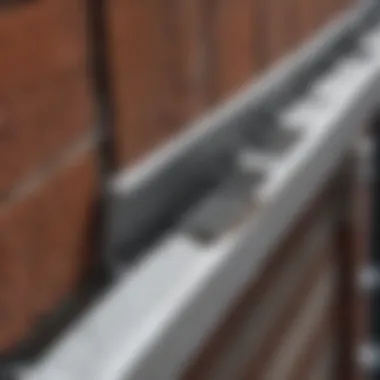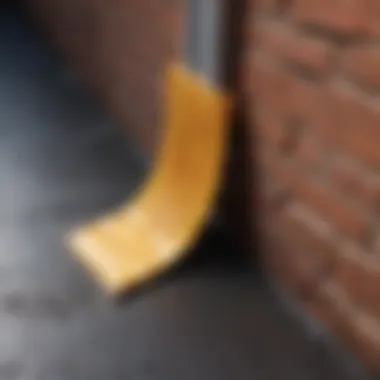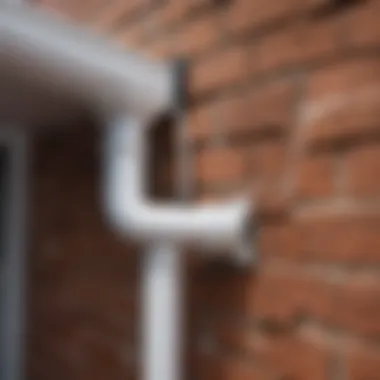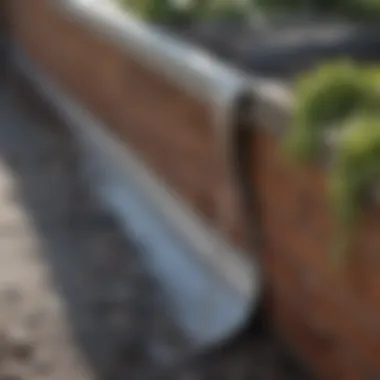Understanding Plastic Gutter Downspout Extensions


Intro
A safe and effective drainage system is a critical component in any home. Among the various elements of this system, plastic gutter downspout extensions play a pivotal role. These extensions direct water away from the foundation of a house, preventing potential water damage and related issues. In this section, we will explore the significance of these extensions and how they function in enhancing your home’s water management system.
Overview of Topic
Plastic gutter downspout extensions serve a fundamental purpose in the realm of home improvement. They are designed to lead rainwater further away from a structure, minimizing the risk of water pooling around the foundation. This is particularly important for homeowners who live in areas experiencing heavy rainfall or in regions with poor drainage conditions. Without adequate extensions, water could seep into basements or crawl spaces, leading to mold growth and structural damage.
Understanding the importance of these extensions is crucial for effective home maintenance. By utilizing plastic downspout extensions, homeowners can implement a straightforward measure to protect their property. These extensions offer an affordable solution to a potentially expensive problem, allowing for proactive water management.
Common Challenges and Solutions
Homeowners may encounter several challenges when managing water drainage through gutters and downspouts. Some common issues include:
- Clogged gutters: Leaves and debris accumulate, obstructing water flow.
- Improper drainage: Water may not flow away from the building effectively, leading to pooling.
- Worn out or damaged extensions: Aging materials can crack or break over time.
To tackle these challenges, homeowners can adopt the following solutions:
- Regular maintenance of gutters to prevent clogging. Cleaning them twice a year is generally sufficient.
- Install adjustable downspout extensions that can adapt to various weather conditions and effective water flow needs.
- Replace old extensions with high-quality plastic options that withstand harsh weather.
Product Recommendations
When selecting plastic gutter downspout extensions, homeowners have various choices in the market. Brands like FLEX-Drain, Eagle 1, and GutterMaster offer reliable options. Here are some features to consider:
- Durability: High-quality plastic materials resist cracking and fading from UV exposure.
- Ease of installation: Look for products that come with clear instructions and minimal tools required.
- Adjustability: Some products offer features that allow for easy repositioning based on the flow of water.
Step-by-Step Guides
Implementing plastic gutter downspout extensions can be straightforward. Here is a practical guide:
- Assess your current gutter system: Identify downspouts requiring extensions.
- Select the appropriate extension: Choose an extension that matches the gauge and width of your downspout.
- Cut to size: Measure the distance from the downspout to the preferred drainage area, and cut the extension accordingly.
- Install the extension: Fit the extension onto the downspout securely. Use screws or clamps if necessary to ensure it does not disconnect during heavy rain.
- Test the system: Run water through the gutters and observe if the downspout directs water correctly away from the foundation.
With these steps, homeowners can not only enhance their drainage systems but also prevent future water-related problems.
Properly installed plastic gutter downspout extensions provide an effective solution to managing rainwater runoff.
Prolusion to Gutter Systems
Understanding the basic elements and functionality of gutter systems is essential for effective water management in any property. Gutter systems serve as the first line of defense against water damage by directing rainwater away from the foundation of a house. This section explores the intricate mechanisms of guttering and the significance of a well-planned system.
Overview of Guttering
Guttering consists of channels installed along the edges of roofs. Their primary role is to collect rainwater and guide it towards downspouts. A typical gutter system includes gutters, downspouts, and often extensions.
Gutters come in various materials, including aluminum, steel, and plastic. Each material has differences in durability, cost, and maintenance requirements. They can be sectional or seamless, depending on the homeowner's preference. A properly installed gutter system can significantly reduce erosion, prevent basement flooding, and preserve landscaping integrity.
"A neglected gutter system can lead to costly repairs in the future. Proper installation and maintenance are crucial to protect your investment."
Importance of Proper Water Management
Proper water management is vital in maintaining a safe and structurally sound home. Without effective drainage, excess water can cause various issues, such as:
- Foundation Damage: Excessive moisture can erode the foundation, leading to structural instability.
- Basement Flooding: Improperly managed water can seep into basements, causing mold growth and damage to personal belongings.
- Landscape Erosion: Water runoff can erode garden beds and lawns, leading to loss of plants and soil.
The role of downspout extensions cannot be overstated. They help direct water further away from the foundation, minimizing issues related to pooling or flooding. Homeowners must understand the components of their gutter systems to make informed decisions about maintenance and enhancements.
What is a Downspout Extension?
Downspout extensions are vital components in the functionality of gutter systems. They serve the primary purpose of directing water away from the foundation of a home. This action is essential. When rainwater collects near the base of a building, it can lead to numerous structural issues, including basement flooding and erosion. Therefore, understanding downspout extensions is crucial for effective water management in any property.
Definition and Purpose
A downspout extension is a device attached to the bottom of a downspout. Its role is to control and manage the flow of rainwater from the roof. These extensions are typically made from various materials, including plastic, metal, and rubber. They can vary in length and design to suit specific needs. The main purpose is to ensure water is directed safely away from areas that can suffer from water accumulation.


Types of Downspout Extensions
Several types of downspout extensions are available, each with unique characteristics and advantages.
Rigid Extensions
Rigid extensions are solid tubes or pipes made from durable materials. Their key characteristic is stability once installed. This version is beneficial because it maintains consistent water flow without worrying about shape distortions or blockages. Rigid extensions can handle substantial water volume without bending or collapsing.
However, the solid construction can be less flexible. This may result in challenges during installation in certain areas, especially if specific angles are needed. Overall, their durability makes them a popular choice for many homeowners.
Flexible Extensions
Flexible extensions, on the other hand, are made from bendable materials like rubber or flexible plastic. This feature allows them to conform to various landscaping or installation needs. Their main benefit is adaptability. These extensions can easily navigate around obstacles, which is ideal for properties with complex layouts.
Yet, their flexibility can lead to issues such as kinking, which can disrupt water flow. Homeowners should consider the installation area carefully. If the path is straight, the flexible option may not be as beneficial.
Adjustable Extensions
Adjustable extensions combine features from both rigid and flexible extensions. They usually come with adjustable segments that allow varying lengths. This characteristic makes them extremely versatile, suitable for different drainage needs.
The primary advantage here is that you can customize the extension to fit specific site requirements. However, with adjustability comes potential complexity in installation. Ensuring a secure fit at all joints is crucial to prevent leaks.
"Selecting the right type of downspout extension can drastically improve your property’s water management efficiency."
Understanding downspout extensions assists homeowners in selecting the appropriate type for their needs. A well-chosen extension not only protects a property from water damage but also contributes to the long-term integrity of the gutter system.
Advantages of Plastic Downspout Extensions
Plastic gutter downspout extensions serve as a vital component in effective water management systems. Their significance is not just limited to functionality; they also embody attributes that enhance their utility. This section delves deeply into the advantages that plastic downspout extensions offer, focusing on crucial aspects such as durability, cost-effectiveness, and the ease of installation.
Durability and Longevity
The first advantage to consider is the durability and longevity of plastic downspout extensions. Unlike metal options, which may corrode or rust over time, plastic extensions are resistant to many environmental factors. They can withstand harsh weather conditions, including heavy rain, snow, and UV exposure. This makes them suitable for various climates, ensuring they do not degrade quickly.
For homeowners, this resilience translates into less frequent replacements. An investment in plastic downspout extensions can result in long-term savings. They provide robust solutions without the worry of oxidation or structural failure, which are common challenges in alternative materials.
Cost-Effectiveness
Next, we examine the cost-effectiveness of these extensions. Generally, plastic downspout extensions are less expensive than metal or vinyl alternatives. The lower manufacturing costs reflect in retail prices, making them accessible even for budget-conscious homeowners. Moreover, their longevity further accentuates their value; the initial investment pays off over the years through reduced maintenance and replacement costs.
Another point to consider is the availability of plastic extensions. Because they are widely produced, consumers often find them at local home improvement stores, eliminating shipping costs associated with less common materials. In summary, the combination of lower upfront prices and minimal future expenses makes plastic downspout extensions a financially savvy choice.
Ease of Installation
Lastly, let's address the ease of installation associated with plastic downspout extensions. These extensions are generally lightweight, which simplifies the installation process. Homeowners do not necessarily require a professional to manage installation. With basic tools, such as a screwdriver or a pair of scissors, one can install or modify these extensions without significant effort.
Many products come with user-friendly instructions that guide homeowners through the process. This accessibility allows individuals to take ownership of their drainage systems, avoiding the need for external help. Better yet, the versatility of plastic extensions means they can be cut to desired lengths, offering customization to meet specific drainage needs.
"Choosing the right downspout extension strategy can significantly enhance your home’s overall water management effectiveness."
Considerations When Choosing Extensions
Selecting the right downspout extension is critical for effective water management. Not all extensions suit every home or climate. Understanding specific factors can determine how well these extensions function and ultimately protect your property from water damage.
Local Climate Conditions
Local climate significantly influences the choice of downspout extensions. In areas with heavy rainfall, extensions should channel water away efficiently. Look for designs that can handle sustained water flow without clogging. Conversely, in drier climates, extensions should minimize unnecessary water dispersal that could affect landscaping.
Factors like freeze-thaw cycles can also impact extension durability. In colder regions, materials that resist cracking from freezing temperatures are crucial. Choosing the right extension helps avoid unnecessary repairs and maintenance down the line.
Slope of the Ground
The slope of your ground plays a vital role in how water flows away from your foundation. If the slope is too steep, water may discharge too rapidly and cause erosion. On a flat terrain, water may collect, leading to pooling. Ideally, downspout extensions should complement the existing slope to ensure effective drainage.


It’s also essential to assess how the extension aligns with the natural contour of the landscape. Extensions might require adjustments to avoid pooling near the home’s exterior, which can lead to long-term damage if not properly managed.
Length Requirements
Length is another key consideration when choosing downspout extensions. The extension must extend far enough to direct water away from the foundation, but not so far that it interferes with other landscaping features or structures. Measured accurately, the proper length mitigates risks of erosion and water pooling.
A simple method to determine the right length is to observe where water gathers during rainfall. This can inform how far the extension should reach. It might also be beneficial to consider adjustable extensions which allow fine-tuning, accommodating any changes in landscaping or structural modifications.
"Choosing the right downspout extension can save homeowners from future headaches related to water damage."
Installation Process
The installation process for plastic gutter downspout extensions is crucial for ensuring effective water management in your home. A proper installation helps direct rainwater away from the foundation, preventing potential damage to the structure. It also helps maintain the integrity of the gutter system, ensuring longevity and efficiency. Understanding the installation process allows homeowners to implement best practices and optimize their drainage systems.
Materials Needed
Before starting the installation, it is important to gather all necessary materials. Common items needed include:
- Plastic downspout extensions
- Measuring tape
- Hacksaw or pipe cutter
- Level
- Plumbing adhesive
- Screws and anchors (if applicable)
- Safety goggles
Having these materials at hand ensures a smooth installation process and reduces delays in completing the project.
Step-by-Step Guide
Assessing the Existing Setup
Assessing the existing setup is an essential first step. This involves examining the current downspouts, gutters, and landscape. This assessment allows you to identify potential issues, such as improper sloping or blocked drains, that may need to be addressed before installing extensions. This process helps ensure that the extensions will function properly after installation.
One key characteristic of this step is the identification of the problem areas. Recognizing these areas can save you time and money in the long run. It can also avoid complications during installation. Also, documenting any existing issues can help you make informed decisions on modifications required to your gutter system.
Measuring and Cutting
The next step involves measuring and cutting the plastic extensions to the right size. Accurate measurements are critical for proper fit and function. Measure the distance from the downspout outlet to the desired discharge point. Mark these measurements clearly and use a hacksaw or pipe cutter to ensure clean cuts.
The precision of cutting is a key characteristic, as even small discrepancies can lead to installation challenges. Properly measured and cut extensions are easier to attach and less likely to experience leaks. A unique feature of this step is the ability to customize the extension length based on specific landscape needs. However, too short extensions can lead to inadequate drainage, highlighting the need for caution.
Attaching the Extension
Attaching the extension to the downspout is the final step in the installation process. Alignment is essential here to ensure that the outlet directs water away from the home's foundation. Using screws or plumbing adhesive can provide a secure fit. Make sure to check the level during attachment to guarantee optimal drainage.
This stage is particularly important as the effectiveness of the entire system relies on the secure connection of the extension. A well-attached extension prevents backflow and clogging. One advantage of this final step is that it can be easily adjusted if necessary, such as changing angles or positions based on changing weather conditions or landscape needs.
Maintenance of Downspout Extensions
Maintaining downspout extensions is vital for ensuring effective drainage and avoiding potential damage to your property. Proper maintenance can prevent issues like flooding in your yard and foundation problems in your home. Ignoring downspout extensions could lead to costly repairs or safety hazards. Hence, understanding best practices for maintenance becomes essential for every homeowner.
Regular Inspections
Conducting regular inspections of your downspout extensions allows you to identify potential problems before they escalate. This can be as simple as checking for blockages, cracks, or signs of wear and tear. Inspections should ideally be done at least twice a year, especially during the fall and spring, when debris like leaves can accumulate.
During your inspections, make sure to:
- Look for debris buildup within the extension.
- Check for signs of rust or material degradation.
- Ensure the extension is securely attached to the downspout and functioning correctly.
It's also important to watch for any indications of improper water flow. If you notice water pooling around your home's foundation, it might be time for a thorough evaluation of your downspout setup.
Cleaning and Repairs
Effective cleaning involves removing any debris that can cause blockages. This might include leaves, dirt, and small twigs. A clogged downspout extension will direct water toward your foundation instead of away from it, increasing the risk of water damage.
To keep these extensions functional, follow these steps for cleanings:
- Remove the extension from the downspout. This allows you to inspect the entire length.
- Use a garden hose to flush out any remaining debris. Water pressure often clears blockages faster than manual removal.
- If necessary, scrub the inside with a brush to remove stubborn dirt or algae.
- Inspect for damages such as cracks or loose fittings. These can be repaired using waterproof sealants or specific PVC adhesives suitable for plastic.


It's advisable to take proactive steps towards repairs. Ignoring small cracks can result in larger issues and unexpected costs. If a downspout extension is too damaged to repair, consider replacing it entirely.
"Routine maintenance is not just about fixing what's broken; it's about preventing issues before they arise."
By integrating these maintenance practices, homeowners can extend the lifespan of their downspout extensions and safeguard their properties against water-related problems.
Common Issues and Solutions
The effective functioning of plastic gutter downspout extensions is pivotal for efficient water management. Homeowners need to be aware of common issues that can arise and the solutions available to address them. Understanding these challenges ensures a proactive approach, preventing water-related problems such as excessive pooling or foundation damage.
Clogging and Backflow
Clogging is a frequent issue faced by gutter systems, particularly in downspout extensions. Debris such as leaves, twigs, and dirt can accumulate, obstructing the flow of water. When this happens, water may not drain properly, leading to backflow.
Regular maintenance is key to prevent these blockages. Here are some strategies to manage clogging:
- Install Leaf Guards: These can help prevent debris from entering the downspout.
- Routine Cleaning: Schedule periodic inspections to clear any buildups.
- Water Flow Checks: After heavy rains, observe if water flows effectively.
- Consider Slope: Ensure the downspout is angled correctly to direct water away from the foundation.
"Clogging not only leads to backflow, but can also cause damage to gutters and extensions over time if not addressed."
Improper Angling
Proper angling of downspout extensions is crucial. If the angle is incorrect, water may not flow away from the house as intended. This can result in standing water near the foundation, which can cause serious structural issues.
To ensure the downspout is properly angled, consider the following:
- Check the Slope: A downward angle away from the house is essential. It should typically slope at least 1 inch for every 8 to 12 feet of extension.
- Utilize Adjustable Extensions: These allow for easy angling adjustments based on the landscape.
- Monitor During Rain: Observe the flow during rainstorms to confirm if the water is channeling correctly.
Addressing these common issues with diligence can prolong the life of your gutter systems and improve your home's water management efficiency. Recognizing the symptoms of clogging and improper angling facilitates timely intervention, ensuring that you maintain a functional and effective drainage system.
Innovative Designs in Downspout Extensions
Innovative designs in downspout extensions play a critical role in enhancing the effectiveness and aesthetic appeal of gutter systems. These designs are essential not only for efficient water management but also for adding an element of style to homes. In this section, we will explore unique decorative options as well as practical functional innovations.
Decorative Options
When considering decorative options for downspout extensions, homeowners have the chance to personalize their exterior spaces. Stylish designs can complement the architecture of a house while serving the foundational purpose of redirecting water away from the property. Common decorative choices include:
- Custom Colors and Finishes: Many extensions now come in a variety of colors to match the house. Paint or coatings can provide an extra layer of protection against the elements while enhancing visual appeal.
- Artistic Shapes and Patterns: Non-standard shapes such as spirals or curves can transform a traditional downspout into an art piece. Some manufacturers offer customizable textures or designs that can symbolize the homeowner's unique taste.
- Integrated Planters: Certain modern designs allow for planters to be attached to the downspout. These options utilize the downspout as a water source for plant life, providing an eco-friendly, beautiful solution.
Incorporating decorative elements not only provides a visual upgrade but can also increase the overall value of the home. Homeowners can express individuality through these styles, creating a more inviting atmosphere in their gardens or yards.
Functional Innovations
Functionality cannot be overlooked when exploring downspout extensions. Innovative designs are increasingly prioritizing efficiency and practical use, ensuring they effectively direct water while minimizing potential problems. Here are some notable functional innovations:
- Rainwater Harvesting Systems: Some downspout extensions are designed to collect rainwater. This water can then be used for irrigation or other non-potable uses, making it an environmentally conscious choice.
- Self-Cleaning Features: Recent advancements include self-cleaning downspout systems that utilize specific materials or mechanics to prevent clogging. This can greatly reduce maintenance efforts and extend the lifespan of the downspouts.
- Adjustable Lengths: Extensions made with adjustable lengths allow for flexibility in installation. This is particularly beneficial in regions with variable terrain, ensuring that homeowners can customize the direction and distance of water runoff.
Utilizing these functional innovations can significantly enhance the performance of gutter systems. Homeowners can opt for designs that not only solve practical issues but also contribute to sustainable living practices.
"Investing in innovative designs for downspout extensions is not just about aesthetics, but about a smarter way to manage water that protects your property and the environment."
In summary, the importance of innovative designs in downspout extensions lays in their dual ability to beautify and enhance functionality. By considering both decorative and functional elements, homeowners can achieve a balance between appearance and performance, ultimately leading to better water management and a more appealing property.
Ending
In concluding this comprehensive examination of plastic gutter downspout extensions, it is essential to recognize their crucial role in residential water management. The effectiveness of a gutter system hinges on its ability to divert water efficiently away from the foundation of a home. Plastic downspout extensions facilitate this process by providing a targeted means of directing water away from potentially problematic areas, thus safeguarding the integrity of the property.
Summary of Key Points
- Functionality: Plastic downspout extensions serve the fundamental purpose of channeling rainwater away from the home’s foundation. This reduces the risk of water pooling and potential damage.
- Material Benefits: The durability and weather-resistance of plastic makes these extensions a practical choice. They endure various environmental conditions, ensuring long-term performance.
- Installation Ease: Many homeowners appreciate the simplicity of installing plastic downspout extensions. Their lightweight nature and compatibility with standard downspouts allow for expedient setup without the need for professional assistance.
- Maintenance Considerations: Regular inspections, cleaning, and timely repairs help to facilitate optimal functioning. Being proactive in maintenance can prevent issues such as clogging or improper angling.
Final Thoughts
Ultimately, understanding the utility and installation of plastic gutter downspout extensions equips homeowners with the knowledge necessary to enhance their drainage systems. Making informed decisions while selecting these extensions can lead to significant long-term benefits. Engagement with the maintenance and traditional structures will become beneficial in preserving the health of one's property.
"Investing time and resources in properly functioning gutter systems can save homeowners from extensive repair costs in the future."
In summary, plastic downspout extensions present a compelling solution for effective water management, allowing for peace of mind when dealing with rainfall and drainage. Homeowners can enjoy the benefits of a well-maintained property while contributing to the overall efficiency of their gutter system.







